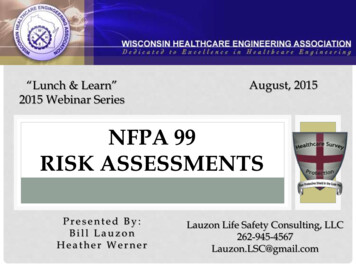
Transcription
“Lunch & Learn”2015 Webinar SeriesAugust, 2015NFPA 99RISK ASSESSMENTSPresented By:Bill LauzonHeather WernerLauzon Life Safety Consulting, LLC262-945-4567Lauzon.LSC@gmail.com
NFPA 99RISK ASSESSMENTSLauzon Life Safety Consulting, LLC262-945-4567Lauzon.LSC@gmail.com 2
NFPA 99RISK ASSESSMENTSPresented by:Bill LauzonHeather WernerLauzon Life Safety Consulting, LLC262-945-4567Lauzon.LSC@gmail.com3
CURRENTLYUSE NFPA 991999 EDITION4BIGGEST IMPACT: NEW HOSPITALS
IF 2012 LSC GETS ADOPTED:5
IF 2012 LSC GETS ADOPTED:MAY APPLY TOALLHOSPITALS&NURSINGHOMES6
TOTALLY RE-WRITTENRequirementsChange From:Occupancy-BasedtoRisk-Based7
TOTALLY RE-WRITTENRequirementsChange From:Occupancy-BasedtoRisk-Based“You DO IT if thespace is health care,regardless if there isa need”8
TOTALLY RE-WRITTENRequirementsChange From:Occupancy-BasedtoRisk-Based“You DO IT if thespace is health care,regardless IF there isa need”9
TOTALLY RE-WRITTENIn other words:You get to evaluatewhich requirementsapply to yoursituation10
REORGANIZED CHAPTERS11
Re-Organized Chapters19993 – Electrical Sys4 – Gas & Vacuum5 – Envir6 – Materials7 – Elec Equipment8 – Gas Equipment9 – Mfr Requirements10 – Laboratories11 – Emergency Prep12 – Hospital13 – Other Health16 – Nursing Home17 – Limited Care18 – Home Care19 - Hyperbaric20124 – Risk Assessment5 – Gas & Vacuum6 – Electrical Sys7 – Info Technology8 – Plumbing9 – HVAC10 – Elec Equipment11 – Gas Equipment12 – Emergency Mgmt13 – Security Mgmt14 – Hyperbaric15 – Features of Fire Prot12
9 Gone19993 – Electrical Sys4 – Gas & Vacuum5 – Envir6 – Materials7 – Elec Equipment8 – Gas Equipment9 – Mfr Requirements10 – Laboratories11 – Emergency Prep12 – Hospital13 – Other Health16 – Nursing Home17 – Limited Care18 – Home Care19 - Hyperbaric20124 – Risk Assessment5 – Gas & Vacuum6 – Electrical Sys7 – Info Technology8 – Plumbing9 – HVAC10 – Elec Equipment11 – Gas Equipment12 – Emergency Mgmt13 – Security Mgmt14 – Hyperbaric15 – Features of Fire Prot13
6 New19993 – Electrical Sys4 – Gas & Vacuum5 – Envir6 – Materials7 – Elec Equipment8 – Gas Equipment9 – Mfr Requirements10 – Laboratories11 – Emergency Prep12 – Hospital13 – Other Health16 – Nursing Home17 – Limited Care18 – Home Care19 - Hyperbaric20124 – Risk Assessment5 – Gas & Vacuum6 – Electrical Sys7 – Info Technology8 – Plumbing9 – HVAC10 – Elec Equipment11 – Gas Equipment12 – Emergency Mgmt13 – Security Mgmt14 – Hyperbaric15 – Features of Fire Prot14
6 Re - Arranged19993 – Electrical Sys4 – Gas & Vacuum5 – Envir6 – Materials7 – Elec Equipment8 – Gas Equipment9 – Mfr Requirements10 – Laboratories11 – Emergency Prep12 – Hospital13 – Other Health16 – Nursing Home17 – Limited Care18 – Home Care19 - Hyperbaric20124 – Risk Assessment5 – Gas & Vacuum6 – Electrical Sys7 – Info Technology8 – Plumbing9 – HVAC10 – Elec Equipment11 – Gas Equipment12 – Emergency Mgmt13 – Security Mgmt14 – Hyperbaric15 – Features of Fire Prot15
HIGHLY RECOMMENEDBuy the HandbookExplanations of themany changes Expert insightsDescriptive photosHelpful tables & chartsMore expensive, butwell worth it16
NFPA Members:10% discount 70.50 – Book or PDF 151 – Book or PDF17
BOOK Easy to flip to referenced sections Can copy & show othersPDF Easy to search for topicsNFPA Free Access FreeNon-seachableNon-copiableNon-flippable18
TODAY’S FOCUSChapter 4RiskAssessment19
RISK ASSESSMENTIt guides the use of theother chaptersNot: IT, Emerg& SecurityMgmt, Fire Protection20
Chapter 4RISKASSESSMENTApplies to:Not to:20124 – Risk Assessment5 – Gas & Vacuum6 – Electrical Sys7 – Info Technology8 – Plumbing9 – HVAC10 – Elec Equipment11 – Gas Equipment12 – Emergency Mgmt13 – Security Mgmt14 – Hyperbaric15 – Features of Fire Prot21
4.1 – Building Systems Categories1High PatientImpact2Minor PatientImpact3Slight PatientImpact4No PatientImpactConsider equipmentoperationNOTIntervention bypeople22
4.1 – Building Systems CategoriesConsider equipment operationNOT intervention by peopleSEVARITY OF FAILURE Harm to PatientsHarm to Staff & VisitorsRELIABILITY Importance of redundancyProbability of system failureLevels of sedationComplexity of treatment23
4.1 – Building Systems CategoriesConsider worst-outcome scenarioof a failure impactMajor/DeathMinorNoHarmDiscomfortFactor A - HARM to PATIENTSjklmFactor B – RELIABILITY bleNo Impacton Pt Care24
4.1 – Building Systems CategoriesEvaluate effect of failure,Based on harm to patients, staff & visitors12Failure may causedeath or serious injuryFailure limited tominor injuries34Failure may causediscomfortNo impact on patientsor caregivers25
4.1 – Building Systems CategoriesEvaluate potential for failure,Based on system reliability1System must alwayswork (life support)3NormalReliability Needed2High ReliabilityExpected4No Impact onPatient Care26
Category 1Failure likely to cause major injury/death1Available at all timesfor life-supportsystemsSystem must alwayswork (life support)Major injury Any amputation Loss of sight, or injury to eye Unconsciousness that requiresresuscitation, medicaltreatment, or hospital admit Acute illness from biologicalagents27
Category 1Failure likely to cause major injury/death1Available at all timesfor life-supportsystemsSystem must alwayswork (life support)Examples of FailuresIn this category Emergency power to OR's Medical gas system in ICU Ventilator-assisted procedurein a MOB Cardiac cauterization imagingequipment28
Category 2Failure likely to cause minor injuryMinor injury2Failure limited tominor injuries Not serious Not involving risk to lifeHigh ReliabilityExpected29
Category 2Failure likely to cause minor injury2Failure limited tominor injuriesHigh ReliabilityExpectedExamples of FailuresIn this category Task or procedural lighting inpatient rooms Potable water in the patientcare areas30
Category 3Failure not likely to cause injury, but maycause discomfort3Failure may causediscomfortNormal ReliabilityNeededExamples of FailuresIn this category Heating system in southern US Humidity control in nonoperating areas Dental drill Motorized bed adjustments Cooling tower makeup water innw US31
Category 4Failure would have no impact onpatient careExamples of FailuresIn this category3Failure may causediscomfortNormal ReliabilityNeeded Gray water lawn sprinklingSeasonal lighting systemsPublic address systemPneumatic tube systemsVacuum systems in a researcharea32
RISK ASSESSMENTMust follow & documentaccording to a DEFINEDrisk assessment procedureExamples:ISO 31010 – Risk Assessment TechniquesNFPA 551 – Guide for Eval of Fire Risk AssessmentsSEMI S10-0307E – Guidelines for Risk Assess & EvalOther formal processASHE Risk Tool33
ISO 31010 - RISK ASSESSMENTRisk assessment is part of the core elements of risk management Communication and Consultation Context establishment Risk Assessment, includes:Risk identification,Risk analysis &Risk evaluation Risk treatment Monitoring and reviewRisk can be assessed atany level of a facility’soperations or goals.34
ISO 31010 - RISK ASSESSMENTThere are 31 risk assessment techniques in Annex B of ISO/IEC 31010Amazon Cause & effect analysis Brainstorming 298 Full & semi-structured interviews Layer protection analysis192 pages Decision tree Dephi methodsoftcover Human reliability analysis Checklist Bow tie analysis Preliminary hazard analysis Reliability centered maintenance Hazard & operability study Hazard analysis & critical cont pts Sneek circuit analysis Markov analysis Toxicity assessment Monte Carlo simulation Structured “What-If” technique Bayesian statistics & Bayes nets Scenario analysis FN curves Business impact analysis Risk index Root cause analysis Consequence/probability matrix Failure mode & effects analysis Cost/benefit analysis Fault tree analysis Multi-criterial decision analysis Event tree analysis Cause & consequence analysis35
ISO 31010 - RISK ASSESSMENTThere are 31 risk assessment techniques in Annex B of ISO/IEC 31010Amazon Cause & effect analysis Brainstorming 298 Full & semi-structured interviews Layer protection analysis192 pages Decision tree Dephi methodsoftcover Human reliability analysis Checklist Bow tie analysis Preliminary hazard analysis Reliability centered maintenance Hazard & operability study Hazard analysis & critical cont pts Sneek circuit analysis Markov analysis Toxicity assessment Monte Carlo simulation Structured “What-If” technique Bayesian statistics & Bayes nets Scenario analysis FN curves Business impact analysis Risk index Root cause analysis Consequence/probability matrix Failure mode & effects analysis Cost/benefit analysis Fault tree analysis Multi-criterial decision analysis Event tree analysis Cause & consequence analysis36
NFPA 551- FIRE RISK ASSESSMENT 45 at NFPA30 pagessoftcover37
SEMI S10-0307E -RISK ASSESSMENTSUPERSEDED BY SEMI S10-0215SEMI:Semi-Conductor Equipment & Materials International 300 at SEMI onlinedownload38
ASHE- RISK ASSESSMENTINSTRUCTIONS&3 WORKSHEETSFree download ofExcel Spreadsheet toASHE members39
ASHE- RISK ASSESSMENT“Instructions” explains how touse the 3 worksheets40
ASHE- RISK ASSESSMENT1. “Systems “worksheet is usedto enter & record the RiskCategory # for the varioussystems within a given space41
ASHE- RISK ASSESSMENT2. “Equipment” worksheet is used toenter & record the Risk Category #for facility equipment42
ASHE- RISK ASSESSMENT3. “Emergency Mgmt” worksheetused to enter & record the RiskAssessment for buildings43
ASHE- HAZARDVULNERABILITY ANALYSISSimilar to H-V Tool of 201444
ASHE- RISK ASSESSMENTArticle from:“Inside ASHE”Summer 2015 issueASHE Conferencepresentation byGeorge Mills, TJCHospitals need to do riskassessments NOW forcompliance with:EC.02.01.01 EP 1 – Identify RisksEC.02.01.01 EP 3 – Take Action45
ASHE- RISK ASSESSMENTLet’s take anotherlook at the ASHEspreadsheet46
ASHE- RISK ASSESSMENTStep 1 – List EVERY room& space in the facility47
ASHE- RISK ASSESSMENTStep 2 –Evaluate & document the risk forEACH utility system48
ASHE- RISK ASSESSMENT1. Grab a floor plan49
ASHE- RISK ASSESSMENT 2. Methodically list every room 50
ASHE- RISK ASSESSMENTList every room51
ASHE- RISK ASSESSMENT3. Methodically evaluate the risk(1-4) for EVERY Utility in everyroom52
ASHE- RISK ASSESSMENTASHE Form is missing documentation ofHOW you figured the Risk Categories 1. Evaluation of patient impact2. Evaluation of system reliability53
LLSC- RISK ASSESSMENTSYSTEMSROOMSChanges from the ASHE form:Switched H & V to fit on a letter sheet54
LLSC- RISK ASSESSMENTAdded lines to document the “harm”& “reliability” evaluations55
LLSC- RISK ASSESSMENTExcel file available via e-mail request to:Lauzon.LSC@gmail.com56
NFPA 99 - RISK ASSESSMENTDevelop a uniform Risk Assessment processBest to coordinate with: Quality ImprovementInfection PreventionEnvironment of CareThey usually have experience in risk assessments57
ASHE- RISK ASSESSMENTWHAT do you dowith thisjumble of numbers?58
Now let’sApply the Risk CategoriesTo the NFPA 99 Chapters12High Patient ImpactMinor Patient Impact34Slight Patient ImpactNo Patient Impact59
Applying the Risk Categories5 – Gas & Vacuum6 – Electrical Sys7 – Info TechnologyApply8 – Plumbing9 – HVAC10 – Elec Equipment11 – Gas Equipment12 – Emergency Mgmt13 – Security MgmtNot Apply14 – Hyperbaric15 – Features of Fire Prot60
NFPA 99 – CHAPTER 5GAS & VACUUM SYSTEMSOrganized by RiskCategory requirements(not retroactive, except for operation& management requirements)61
NFPA 99 – CHAPTER 5GAS & VACUUM SYSTEMS62
NFPA 99 – CHAPTER 5GAS & VACUUM SYSTEMS201219991High PatientImpactLevel 1Hospital2Minor PatientImpactLevel 2HospitalASC3Slight PatientImpactLevel 3Dental4No PatientImpactNewRisk Categoriesare similar tothe formerLevel 1Level 2Level 363
NFPA 99 – CHAPTER 5GAS & VACUUM SYSTEMS201219991High PatientImpactLevel 1Hospital2Minor PatientImpactLevel 2HospitalASC3Slight PatientImpactLevel 3Dental4No PatientImpactUnder the 1999editionhospitals hadto follow thisUnder the 2012edition HEALTHCARE FACILITIEScan do any of these(depending on thepatient risk)64
NFPA 99 – CHAPTER 5GAS & VACUUM SYSTEMS5.X.14 - MAINTENANCE1High PatientImpact5.12Minor PatientImpact5.23Slight PatientImpact5.34No PatientImpactNAInventory includes all sources,control valves, alarms & mfrassembliesMust have scheduled inspectionsbased on risk assessment & OEMrecommendations (minimumannual). Very prescriptive lists ofwhat must be included.Maintainers must be qualified bytraining or credentialing65
NFPA 99 – CHAPTER 6ELECTRICAL SYSTEMSNot organized by Risk CategoriesSimilar to 1999 standardStill organized by the“Type” of EESCode lists which sections are retroactive,such as GFI, # receptacles, OR wet locations66
NFPA 99 – CHAPTER 6ELECTRICAL SYSTEMSBIG change: ORs are now a“wet” environment by defaultUnless a Risk Assessmentdetermines otherwise6.3.2.2.8.4 (not retroactive)67
NFPA 99 – CHAPTER 7INFO TECHNOLOGY SYSTEMSNEW ChapterOrganized by Risk CategoriesLow-voltage voice, data,communications &biomed systemsNURSE CALL is now regulated!(Code does not say chapter is notretroactive, so many inspectors mayapply it to existing)68
NFPA 99 – CHAPTER 7INFO TECHNOLOGY SYSTEMS1High PatientImpact7.32Minor PatientImpact7.43Slight PatientImpact7.54No PatientImpactNA75% of the Chapterdeals with RiskCategory 169
NFPA 99 – CHAPTER 7INFO TECHNOLOGY SYSTEMS7.3.1 – Infrastructure1High PatientImpact7.3.2 – SystemsNo requirements(reserved for futurecode development) Building EntranceData CenterTelecom Equip RmPower RequirementsPathways7.3.3 – Nurse Call Patient CallEmergency CallStaff Assist CallEmergency Resuscitation (many other sys reserved forfuture code development)70
NFPA 99 – CHAPTER 8PLUMBING SYSTEMSNEW Chapter(very short) Potable WaterNonpotable WaterSpecial Use WaterGrease InterceptorsBlack Waste WaterGray Waste WaterClear Waste WaterFuel Non-med Compressed Air Water Conditioning Water Heating(not retroactive)71
NFPA 99 – CHAPTER 8PLUMBING SYSTEMS1High PatientImpact2Minor PatientImpact3Slight PatientImpact4No PatientImpact8.2 For each plumbing componentsystem, the facility must designate riskcategory for each building space.8.2.1 The risk category of eachplumbing system shall beindependent of the category applied toother systems that serve the samespace.72
NFPA 99 – CHAPTER 8PLUMBING SYSTEMSSampleTable73
NFPA 99 – CHAPTER 9HVAC SYSTEMSNEW Chapter (short)HeatingCoolingVentilationProcess(not retroactive)74
NFPA 99 – CHAPTER 9HVAC SYSTEMS1High PatientImpact2Minor PatientImpact3Slight PatientImpact4No PatientImpact9.2 For each HVAC componentsystem, the facility must designate riskcategory for each building space.9.2.1 The risk category of each HVACsystem shall be independent of thecategory applied to other systems thatserve the same space.75
SampleTableSYSTEMSNFPA 99CH 9HVAC76
NFPA 99 – CHAPTER 9HVAC SYSTEMSADOPTED BY REFERENCE ASHRAE 170 for spaces listed in that stdASHRAE 90.1 for energy & commissioningNFPA 90A for ductworkNFPA 55 for transfillingNFPA 110 for emergency power room77
NFPA 99 – CHAPTER 10ELECTRICAL EQUIPMENTNot organized by Risk CategoriesSimilar to 1999 standardPrimarily on TESTING Patient-Care related equip Non-Patient equipment Laboratory equipment(retroactive)78
NFPA 99 – CHAPTER 11GAS EQUIPMENTNot organized by Risk CategoriesSimilar to 1999 standard Cylinder RequirementsCylinder StorageGas Equipment TestingTransfilling & Liquid OxygenTesting Requirements(retroactive)79
NFPA 99RISK ASSESSMENTSARE YOUREADY ?(Get started now)80
“Lunch & Learn”2015 Webinar SeriesNFPA 99RISK ASSESSMENTSLauzon Life Safety Consulting, LLC262-945-4567Lauzon.LSC@gmail.com81
Checklist Preliminary . There are 31 risk assessment techniques in Annex B of ISO/IEC 31010 . VULNERABILITY ANALYSIS Similar to H-V
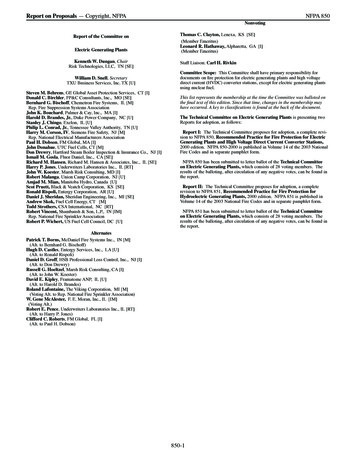
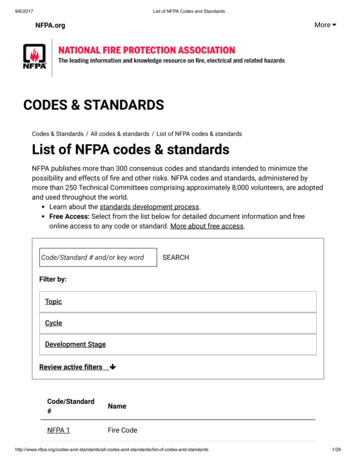
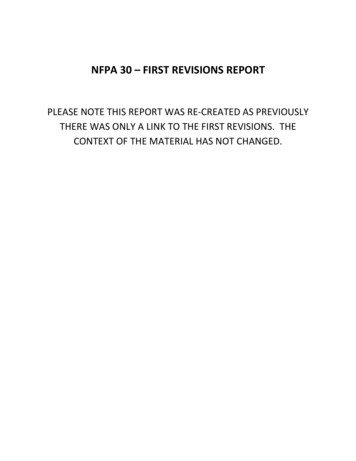
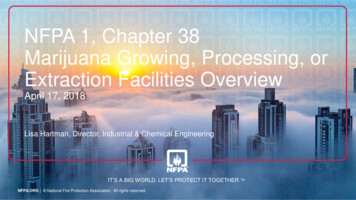


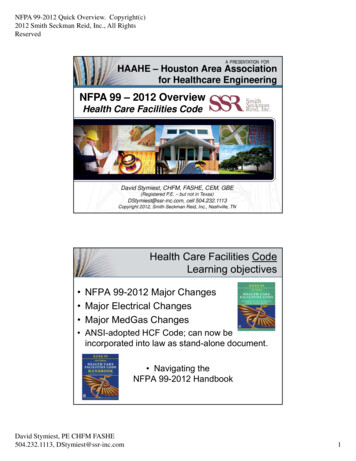
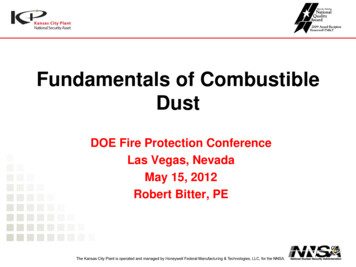
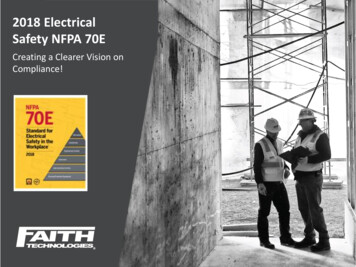
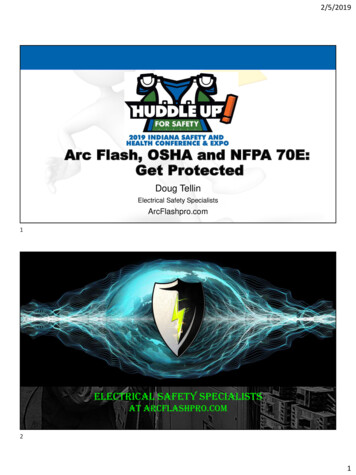
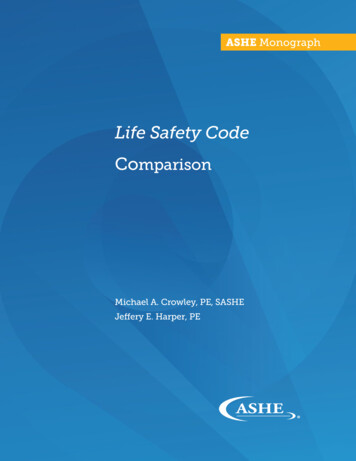
![First Revision No. 3-NFPA 497-2014 [ Chapter 2 ]](/img/5/497-a2016-eec-aaa-fd-frstatments.jpg)